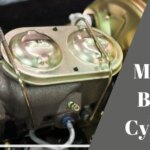
Why my brake lights won’t turn off? A vehicle’s brake lights should always be in good working order. This protects you and other drivers on the road. While driving, the vehicle after you will notice your taillights. This is especially true if the brake lights refuse to turn off. In this article, I’ll walk you through how brake lights work, possible reasons for brake light not going off, and how to fix them.
Table of Contents
Brake Lights: How Do They Work?
A brake lights system consists of many components:
- brake pedal
- striker
- brake light switch
- light bulbs
- fuses
- wiring
They are all part of your brake system as it relates to your lights. When you depress the brake pedal, it makes contact with the brake light switch attached to it, allowing the brake lights to activate.
By way of the electrical components, this switch informs the brake lights that now the pedal has been depressed. When you take your foot off the brake pedal, the striker disconnects the brake light switch, turning off the brake lights. Although this is a simple description of how brake lights function, failure of the brake light switch or the striker may result in brake light malfunctions.
NOTE: If your brake lights remain even while your vehicle is parked, your battery will be depleted. It’s critical to address brake light issues as soon as possible to avoid draining your battery.
Why My Brake Lights Won’t Turn Off?
It’s aggravating not to be aware that your brake lights are on while driving. These are some of the reasons for this particular malfunction:
Brake light switch failure
A malfunctioning brake light switch is a typical cause of automotive brake lights that can’t even turn on. This part is located beneath your dash, next to the brake pedal. If your lights aren’t working, it’s possible that the door is stuck shut or that the part has broken.
The brake light coming on while riding, vehicle not shifting out of park, impaired cruise control, and non-functioning brake lights are all signs of a malfunctioning brake light switch.
Riding the brakes
This is a pretty prevalent issue, especially among inexperienced drivers. You place your left foot softly on the brake pedal as you drive. Yes, your foot is now prepared to use the brakes. It’s not a bad concept at all. However, please remember that even a quarter of an inch of pressure on the brake pedal will trigger the brake lights.
If your automobile has an automatic gearbox and you usually brake with your left foot, be sure you don’t rest your foot on the brake pedal.
The brake pedal is stuck
You may well have a stiff brake pedal if your brake pedal does not return to its usual position after you press down on it. Corrosive components or debris in the brake pedal system are generally to blame. You risk damaging the vehicle’s brake pads or rotor if this problem persists and isn’t handled soon.
Striker is worn or missing
A striker is found near the top of the brake pedal linkage on many cars. When you take your foot from the brake pedal, this part disconnects the brake light switch. This striker may fail, degrade, or be moved at any time. The switch may well not disengage as a result, and the brake lights may remain lighted. A broken striker is the most likely cause of parts on your floorboard.
Problems with the circuitry
Faulty wiring can sometimes be the cause of brake lights that won’t switch off or on. This could be the problem if you’ve done everything to have your brake lights repaired but they still won’t switch off or on. To guarantee that your brake lights do not have a wiring issue, get your car inspected by a skilled mechanic.
How to Make Sure Your Brake Lights Are Working Properly
Checking the operation of the brake lights can be done in a number of ways. While you may prefer to let your sophisticated instrument panel do the job for you, nothing beats experiencing brake light behavior for yourself. Here are a few simple ways to go about it:
#1 Seek help from a friend
Having a friend, family member, neighbor, or passenger either touch the brake pedal as you watch or check the lights while you do the footwork is obviously the easiest way to test your brake lights.
#2 Reflection on the storefront window
When you’re not at home, look for a shopping complex with parking just in front of the store. The storefront window can be used as a mirror. Back your automobile into a parking slot in front of a glass window if traffic and pedestrians allow.
Apply the brakes after looking in the rearview mirror. If everything is in order, all of the brake lights should illuminate. You should also inspect your back turn signals and emergency flashers.
Rep with the engine turned off and the ignition turned off. Make a note of any areas where the lights are not working so that you can take action in the future. The turn signals can not work if the engine is turned off.
#3 Use garage door
Bring the car into the garage and shut the gate behind you if you’re at home. When you press the stop pedal in a dark garage, you’ll be able to see if your brake lights are showing on the garage door through the rearview or side mirrors.
This technique can also be used in an enclosed parking garage away from the home. Simply return to your parking spot and, when you use the brakes, check your rearview mirror for brake light operation.
How to Repair a Bad Brake Light
These are some of the most typical methods for repairing a broken brake light.
The brake pedal must be replaced
An issue with the brake pedal is one of the most prevalent reasons why the brake light won’t turn off. It’s either stuck in place or slightly pressing the switch. Alternatively, dirt and debris have gathered on the brake light switch, making it impossible for the lights to turn off.
If that’s the case, you may feel relieved because this is a simple cure. You will only need an old toothbrush to clean the contact points between the switch and the pedal. The majority of the muck can be removed this way. After then, repeatedly press the brake pedal to return it to its original position.
Broken brake pedal stopper repair
When the brake pedal is pressed on, the stopper prevents the pedal from sliding too far down. Brake pedal stoppers are made of strong plastic and might wear out over time due to continuous use. They may become misaligned from their initial position if they become loose.
Repairing the brake circuit’s wiring
The brake lights may refuse to turn off due to a short circuit in the wiring. This basically means that the circuit is sealed despite the fact that the switch is open. Examine the pigtail harness that connects the brake light switch to the pigtail harness.
Any indicators of deterioration, such as rodent chew marks, and burnt plastic marks are serious issues. It is acceptable for you to attempt to repair the wire harness (given you have experience in this). However, any expert technician would warn you that harness replacement is far more cost-effective and prudent.
Repairing the brake light switch
The brake light switch is an analog type, which is subject to mistakes. This means that to close or open the circuit, you must manually press the device. Wear and tear on the operation of this switch may cause it to fail after a lengthy period of operation. It, of course, breaks down.
You shouldn’t even try to fix the brake light switch. There’s a good chance you don’t have the necessary skills and tools. If you’re positive the brake light switch is the source of the problem, remove it and replace it with a new one.
Conclusion
The most likely cause of your car’s brake lights not turning off is a stuck or faulty switch. You’ll need to either tweak or replace the switch. Ignoring the issue can only lead to more serious issues in the future. When you keep piling up necessary repairs, it merely adds to your long-term costs. Don’t jeopardize the lives of other people.
Hi there! I’m Naomi O’Colman. I’ve got years of experience working at an auto repair shop here in Texas under my belt. On top of that, ever since I was a kid I’ve been passionate about the auto industry. Since I’ve joined the team at automotivegearz.com I’ve been enthusiastically sharing my passion and insights with my readers. I’m dedicated to delivering high quality content and helping you stay up to date with the latest automotive trends and products out there!







